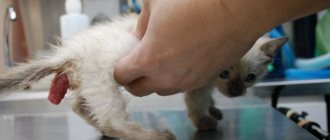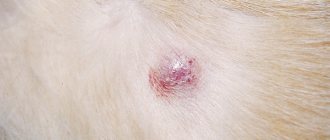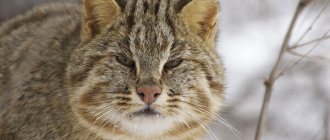The process of vomiting in a cat is no different in nature from vomiting in a person: thus, the stomach rejects the substances that have entered it and throws them out of the body through the mouth or nose. Vomiting is a protective reaction that clears the gastrointestinal tract of foreign or toxic contents. The appearance of this symptom in most cases indicates a disturbance in the functioning of the digestive system, when the stomach cannot digest the substances that enter it.
Course of pregnancy
During the entire period of gestation, the animal must be under the constant supervision of a doctor and owner.
The usual physiological process of development of a fertilized egg in a cat’s body lasts from 55 to 63 days. This period is influenced by the breed of the animal and the number of kittens that should be born. Only a pregnancy with a large number of fetuses can reduce the gestation time. The picture of the development of the special state of the animal is as follows:
If the mating is successful, then the first few weeks for the animal become more drowsy.
- In the first 3 weeks, behavior changes: the cat sleeps a lot of time, eats more and moves less. Closer to 21 days, the nipples swell and become pink.
- During 4-6 weeks, characteristic features of pregnancy appear. The belly gradually becomes rounder, and after 40 days it begins to grow rapidly. During this period, the veterinarian can feel the number of embryos.
- At 7-9 weeks, the cat's appetite decreases, but she still sleeps a lot. If you put your hand on your stomach you can feel the babies moving. The closer the 63rd day, the lower the stomach drops (located in the hip area). The animal does not leave its owner, but at the same time is looking for a place to build a nest for its offspring.
Visible symptoms
The fact that a cat is pregnant can be assumed by changes in its character and behavior; only a veterinarian can make an accurate diagnosis. There are no obvious symptoms to be noticed immediately after mating; the first characteristic signs that will indicate the imminent appearance of kittens will appear after fertilization only after 3 weeks. The following visible, distinctive signs are distinguished:
A manifestation of this condition in an animal is an enlargement of the mammary glands.
- enlarged mammary glands;
- low physical activity;
- lethargy and drowsiness;
- lack or increase in appetite;
- change in taste preferences.
Urgent visit to the veterinarian
The information given above divides the causes of vomiting into two conditional categories: dangerous (manifestation of serious diseases) and not dangerous (removal of foreign objects, excess gastric juice, cleansing the body, etc.). If a cat vomits once or recurs with some regularity, the owner needs to determine how serious the symptoms are and, accordingly, decide whether immediate contact with a veterinarian is necessary or not.
You should seek veterinary help as soon as possible if:
- the cat vomits often and in large quantities, even after the stomach is completely emptied, the animal does not stop urge;
- impurities characteristic of dangerous diseases are constantly present in the discharge
- the pet’s general condition is lethargic, he constantly wants to sleep, he loses his appetite and interest in the world around him;
- there are accompanying symptoms of poisoning - diarrhea, fever, fever;
- The pet's condition is rapidly deteriorating.
When going to the veterinarian, it is better to make an appointment by calling in advance so as not to waste time in queues. With certain diseases, hours and even minutes count – the sooner the veterinarian intervenes, the greater the pet’s chances of recovery. You must take with you all the necessary documents of the animal (their availability and quantity depends on the breed and the club to which the cat belongs). It is also recommended to take a sample of vomit with you to make a diagnosis as quickly as possible.
Is there toxicosis?
With the onset of pregnancy, significant changes occur in the animal’s body, so at the initial stage, pregnant cats may develop a pathological condition that is accompanied by nausea. The unpleasant sensations last for 10-14 days and disappear by the end of 3-4 weeks.
Main reasons
The list of root causes for the development of a pathological condition can be quite large and include a variety of circumstances. Therefore, it is important to provide the most suitable conditions for a cat expecting offspring and monitor its condition. The following factors may cause the development of early toxicosis in an animal:
Worm infestation in an animal can enhance the manifestations of this condition.
- parasitic worms (worms);
- presence of chronic infection;
- disruption of the endocrine system;
- decreased body resistance;
- hormonal disbalance;
- genetic features.
Despite the fairly large list of possible causes for the development of a pathological condition in a pregnant cat, toxicosis during pregnancy is a rather rare phenomenon and short-lived. When a cat is vomiting, there is no need to resort to special treatment, but if the pet’s health is alarming and causes concern, you need to seek help from a veterinarian.
Can toxicosis cause harm?
Toxemia symptoms that appear in the last weeks or days before giving birth may indicate serious problems. In human medicine, the condition is called gestosis. In addition to the “harmless” toxicity, there is a physical effect on the kidneys and liver; in addition, kittens strangle the ureters and impede the functioning of the entire genitourinary system.
Late toxicosis is an acutely developing pathological condition that can lead to the death of the mother and offspring. If you notice vomiting or other signs of poisoning, take your cat to the vet immediately. Most often, detoxification is carried out before the results of blood and urine tests are ready - waiting is very dangerous. What to do next depends on the duration and condition of the animal. If the kittens are full term, a caesarean section is performed; at earlier stages, maintenance therapy is prescribed.
What to do?
Help your cat survive 10 days of discomfort, perhaps by following simple rules:
- Ensure complete rest. During sleep, immune defenses are restored. Restful sleep reduces the risk of contracting diseases during such a difficult period.
- Comfortable conditions. The animal may be nervous, it is important to support the pet, calm it down and pay attention to it.
- Nutrition. There is no need to force people to eat; it is better to offer several types of foods to choose from. It is better to reduce the portion size and increase the number of meals. Water or milk should be available at all times.
It is important to understand that the use of medications for pregnant women is prohibited. If the development of toxicosis occurs against the background of chronic pathology, treatment should only be prescribed by a specialist. You should not resort to self-medication; such a thoughtless approach can only provoke a complication that will negatively affect the cat’s health, but also cause pathological abnormalities in the intrauterine development of the fetus.
With a firm decision to have kittens, owners immediately have a million questions: has the cat successfully mated the cat, and how can you tell if the cat is pregnant, and are there really babies in the belly? We will help you see the first signs of pregnancy in a cat.
How to help a pregnant cat
A responsible owner should know how to help a cat with toxicosis. You need to try and create very good conditions for the cat expecting offspring to bear kittens. First of all, this is a properly balanced diet, which should contain complete vitamins. You can supplement your diet with special healthy supplements, both in the form of some natural products and vitamin complexes.
We suggest you read: Duration of labor in cats
Under no circumstances should you try to force feed a cat during toxicosis if it suddenly refuses regular food.
You just need to offer her other foods and treat her with treats. The body may need to change its usual diet, so the pet has developed whims and tastes have changed. It is possible that there is too much food, and the cat refuses to eat only for this reason. You can slightly reduce the usual portion and observe your changing eating habits.
A pregnant cat needs constant monitoring. Her body adapts to bearing offspring and becomes more vulnerable. If your beloved pet has attacks of nausea in the early stages, then she can and should be helped.
Water should always be available. The same goes for food, even if the kitty refuses it. In this case, it is allowed to reduce the portions, up to a teaspoon. But at the same time, it is advisable to diversify the diet so that the pet can choose its own food. You can't force feed her.
The owner must provide the expectant mother with complete peace and comfort. She may be stressed or nervous. You shouldn’t ignore your worries, it’s better to calm them down. After all, stress weakens the immune system, making it even more vulnerable to diseases.
During pregnancy, a cat needs to sleep a lot. Only in sleep does the immune system work in full force and protect the body from bacteria and viruses. In addition, sleep helps you calm down.
Often, owners of furry female pets are interested in whether cats have toxicosis. And although experts believe that such conditions are unusual for them, some individuals experience attacks of nausea.
Toxicosis in cats indicates hormonal changes in the body. It can occur for any reason. However, in most cases it is not dangerous and does not require medical intervention. But some symptoms, combined with severe and frequent vomiting, indicate pathologies or poisoning.
Signs of successful mating
In order not to wait in vain for something that may not happen, it is advisable for owners of mustachioed pets to navigate the main manifestations of a successful mating. Of course, it is impossible to track the process if animals have free access to the street.
But if the individual is purebred and is constantly looking for a suitable partner, then mating occurs under the control of the owners, so that there is confidence that the coverage is complete. Time will tell whether fertilization occurred or did not occur, but the question of the quality of mating should be excluded.
Basic conditions for successful mating
- The favorable period for mating is considered to be the period between 3 and 5 days from the start of estrus;
- It is better to take the female to the male and it is better from the first day of sexual heat. The cat is not immediately allowed in, but the female is given the opportunity to get used to the situation in someone else’s home;
- Don’t be surprised when on the first day the animals hiss at each other, throw themselves and scratch – this is a natural process of “getting to know each other”. There is no need to interfere too much. At the same time, there is no need to let each other be scratched to death either;
- wait for the cat’s initiative (females are the first to start “flirting” with the male);
- When mating begins, the animals must not be disturbed or distracted so that the male does not suddenly lose interest in the process.
Main manifestations of full coverage
- the cat falls on its side, begins to roll, turning from side to side, sometimes purring;
- the genitals (mucous membrane) swell somewhat (slight swelling against the background of a rush of blood), acquiring a more saturated color than usual;
- the cat usually loses interest in the cat, moves away, and begins to actively lick its genitals;
- if the cat continues to show interest in the female, she will no longer let him near her;
- after 1-3 days, sexual hunting (estrus) ended.
After the above described phenomena, you can take your pet home, starting to wait for the first signs of the cat’s pregnancy.
Features in the early stages
Another symptom that deserves attention is changes in appetite: at first it decreases somewhat, but by the end of the 3rd week of pregnancy, the expectant mother begins to intensively replenish the energy lost during love dates and accumulate new resources for bearing kittens. During this period, the daily amount of food eaten can exceed by 1.5-2 times the norm that was sufficient under normal physiological status.
In the initial stage of pregnancy, some cats may experience toxicosis, manifested by morning nausea and vomiting, and a slight increase in body temperature. This condition, unless accompanied by more serious symptoms, usually lasts no more than 10-14 days and does not require treatment.
The cat's behavior also changes. Always sweet and affectionate, the pet becomes irritable, capricious, and shows aggression towards other animals and its relatives, especially cats. But quite soon, after two or three weeks, the exact opposite picture will be observed: yesterday’s evil fury asks to be held, seeks close contact with the owner, and resumes friendly relations with companion animals.
The very first features of successful fertilization
You should not expect obvious signs of pregnancy to appear in your cat immediately after mating. Something specifically saying that there are kittens in the womb will appear no earlier than 3-4 weeks after successful mating.
Early signs of pregnancy are usually vague, nonspecific and can be confused with general malaise due to some illness.
Most often owners observe:
- Increased sleepiness. Typically, a cat sleeps for about 14 hours. If fertilization is successful, then the “sleepy” period increases by 3-4 hours (it’s impossible not to notice).
- A clear decrease in appetite. To be more precise, liquid, soft food and water are accepted willingly and in abundance, while hard food that must be chewed can be ignored. There is a connection with a general decline in physical strength against the background of hormonal changes and changes in metabolism.
- In the early stages of pregnancy, intense redness of the nipples is observed. This is due to the physiological rush of blood to them. The color changes from coral to deep red. It is important that this symptom is not observed evenly on all nipples - saturation decreases in the direction from the lower to the upper. This phenomenon manifests itself most clearly in first-time mothers.
- Nausea and vomiting. Cats also experience toxicosis during pregnancy - they feel sick and periodically vomit at the very beginning of the period. Nausea is usually manifested by sudden increased salivation, frequent licking, and sometimes a low, drawn-out meow, such as “mao.” The frequency maximum is important - 2-3 times a day and not immediately after meals. This is an important distinction so as not to miss the symptoms of the disease.
- Apathy, indifference to other domestic animals. The pet will behave aggressively towards cats during pregnancy and is absolutely indifferent to other pets.
- Increased affection. Pregnant cats become extremely affectionate, purr more often and more, and almost constantly climb into a person’s lap. This symptom is informative only when an animal that was previously unsociable becomes affectionate.
Interesting fact: cats are considered a kind of “pregnancy detector”. They sense a special smell emanating from pregnant women - be it another animal or even a person - in the very, very early stages.
If a cat suddenly becomes imbued with sudden tenderness towards any pet (dog/cat), rubs against their belly, tries to lick them. It is very likely that she feels the birth of a new life in her womb.
Flair also works with people - mustachioed family members literally do not stick to pregnant women in the first weeks, when this fact is not officially confirmed.
Causes of vomiting
Vomiting in a cat can be caused by many reasons, both everyday and truly dangerous - in some cases it is a symptom of serious diseases that can significantly harm the cat's condition or even lead to death. Treatment of vomiting must begin with a correct determination of the cause of its manifestation, otherwise the methods used may turn out to be completely ineffective or even worsen the situation.
Household causes of vomiting (quite natural and do not pose a serious threat to the health of the animal):
- in one meal the cat ate a large amount of food for its stomach;
- swallowing large pieces too quickly;
- accumulation of hair in the stomach (regular ridding of the body from hairballs that enter it during licking is a natural process);
- rejection of grass by the stomach (cats instinctively eat some herbs themselves to cleanse the gastrointestinal tract of toxins).
Changes in the body by week
The division of signs of pregnancy in a cat by week is very arbitrary, because Each organism is individual. It is impossible to say exactly what week the animal is in. You can track the trend of division into three-week phases:
1-3 weeks
The period is characterized by the earliest symptoms of pregnancy, described in the previous section. The first thing the owners will pay attention to after a successful mating is passive behavior, drowsiness, and decreased appetite in the first 3-4 days.
That is, a general sharp calm in terms of temperament with apathy is the very first sign of a cat’s pregnancy. Symptoms characteristic of toxicosis appear - nausea, vomiting.
In the Scottish breed, toxicosis begins to manifest itself towards the end of this period, and not at the beginning. The incidence of superfetation is also high - estrus appears in the middle of pregnancy (mating with a male cat may occur again if there is one).
Nipples turn pink by the end of 3 weeks. Inattentive owners or people who work a lot and are rarely at home may not notice all these changes. The condition is often confused with obesity and overeating.
See How long does a cat's pregnancy last?
4-6 weeks
At this stage of pregnancy, the cat already notices some rounding of the tummy (from the 30-35th day from the moment of conception). By gently stroking it, you can feel the kittens. From now on you can’t put too much pressure on the abdominal cavity; you shouldn’t try to count the number of babies - nothing will work, and you can very easily harm a pregnant cat.
During this period, appetite increases and food preferences may change. During this period, the British breed's fish supply is reduced. It begins to destroy vitamin B in the body, and it is very necessary for both the mother and the future offspring.
In addition to everything, the cat begins to take care of itself - it does not run, does not jump, does not climb to heights and gets down from it very carefully.
7-9 weeks
The period is characterized by the beginning of active “wiggling” of kittens. By the appearance of movements under the palm of your hand on the stomach or visually when lying on its side, you can already understand for yourself whether the cat’s pregnancy process is normal.
If tremors are not felt at this time, this is a serious reason to contact a veterinarian for advice.
At this stage of pregnancy, the mother cat becomes more restless, almost constantly purrs (“talks” with household members), and is constantly looking for not only a cozy, but also a safe place for childbirth. You may experience increased urination due to increased pressure from the fetus on the bladder.
The external manifestations of pregnancy include swelling of milk bags and nipples, colostrum is released (towards the end of gestation), pigment spots appear on the abdomen in the area of the nipples. The reason for everything is hormonal changes. Body temperature must be reduced to 37°C. If there is a desire or need to measure the temperature, it is better to do this with a “fast” electronic thermometer.
General information about pregnancy
Pregnancy in a cat begins from the moment of fertilization and ends with the birth, as a rule, of several kittens.
Physiological maturity in cats occurs at approximately 5-9 months of age: by this time, the production and content of hormones responsible for the sexual instinct and fertility reaches the required level. Unambiguous evidence of this is estrus, or estrus. The pet’s behavior changes dramatically:
- she becomes restless;
- rolls on the floor;
- rubs against objects;
- urinates more often, sometimes even ignoring the tray;
- constantly and almost continuously meows loudly or screams, calling for cats.
However, no matter what discomfort this period creates, a responsible owner will not follow his pet’s lead, giving her the opportunity to mate. At the age of just over six months, a cat psychologically and physically remains a kitten: the final formation of the skeleton and the formation of internal organs have not occurred, representatives of large breeds still have an active growth phase, and only the established hormonal background indicates readiness for mating.
Causes of toxicosis
For cats expecting offspring, owners must create the most favorable conditions possible. Fluffy pets should receive a balanced nutritional diet and vitamin supplements if the pet is kept on a natural diet. In addition, throughout pregnancy it is very important to closely monitor the condition of your pet and in case of any deviations, if the pregnancy proceeds with complications, be sure to immediately contact a veterinarian.
Important! Two to three weeks before the planned mating, be sure to carry out preventive deworming using special anthelmintic agents for cats. In a month - revaccination.
The pregnancy period begins when the egg is fertilized and a zygote is formed. Of course, it is almost impossible to accurately determine the date, but you still need to know that pregnancy in cats lasts on average 57-68 days. For representatives of the Norwegian, Siberian, and Neva masquerade cats, it is considered normal if the kittens are born on the 62-71st day. But if birth has not occurred by day 73, you should sound the alarm and seek help from a veterinarian.
Causes:
- severe helminthic infestation;
- chronic systemic viral, bacterial, parasitic infections;
- disruption of the endocrine system;
- a sharp weakening of the body's resistance;
- hormonal imbalance;
- severe hormonal imbalance;
- unfavorable living conditions, poor quality diet.
Often the cause of a difficult pregnancy can be intrauterine fetal death, which can be triggered by a variety of exo- and endogenous factors. Injuries to the peritoneum, poisoning with potent poisons, toxins, pesticides, viral and bacterial infections (chlamydia, leptospirosis, toxoplasmosis) can cause the death of kittens and provoke spontaneous miscarriages.
Genetic, breed characteristics, and chromosomal abnormalities can also cause early toxicosis in cats. A similar condition is often noted in Devon Rex, Siamese, Abyssinian, Bombay breeds and their crosses.
Causes
There are a huge number of reasons that provoke such a painful condition. Disturbances in the functioning of the body can occur both due to poor nutrition and genetic abnormalities. However, the most common reasons can still be identified:
- hormonal disorders or hormonal changes;
- poor living conditions;
- poor nutrition;
- failure of the endocrine system;
- decreased immunity
- presence of chronic diseases;
- parasites of internal organs.
Vomiting also occurs against the background of the death of offspring. Injuries, bruises, harmful substances, poisons and much more have an extremely negative impact on intrauterine development. If the kittens die, a miscarriage occurs.
Genetic abnormalities often cause toxicosis in cats during pregnancy. Siamese, Abyssinian, Bombay breeds are susceptible to it, and a similar condition is also observed in Devon Rex and their mixed breeds.
Symptoms of toxicosis in cats
As a rule, symptoms of toxicosis in cats are noted in the initial stages of gestation of kittens, namely, in the first trimester. In rare cases, pets suffer from late toxicosis. In this case, a few days before giving birth, there may be a slight deterioration in the general condition and changes in behavioral manners.
Most of the critical periods during gestation of kittens occur at the stage of embryonic anlages of organ systems. During this period, an increased sensitivity of embryos to the effects of unfavorable factors of various natures is noted, which can lead to a deterioration in the general condition of the cat and provoke congenital anomalies, developmental defects and even cause the death of fetuses.
Toxicosis in cats, as a rule, appears 3-4 weeks after fertilization of the egg and occurs due to complete hormonal changes in the body. The main signs of toxicosis include:
- frequent nausea, morning vomiting, especially after eating;
- stool disorders, diarrhea;
- decreased activity;
- lethargy, drowsiness, apathy;
- changes in behavior;
- disorders of digestive processes;
- deterioration of coat condition;
- loss of appetite, refusal of favorite treats.
You can see mucus and bile in the vomit. At the beginning of pregnancy, a cat's taste habits and behavior patterns may change. Toxicosis in cats can provoke sudden signs of aggression and nervousness. It is also possible that the pet will require affection and constant attention.
In fact, toxicosis is a normal, natural physiological process and its symptoms resolve spontaneously, without any human intervention. The duration of toxicosis should not exceed 7-10 days.
Important! Mild, gradually developing toxicosis does not harm the health of the cat or the fetus. At the same time, if you notice the characteristic signs described above, monitor the condition of your pet very carefully.
If the symptoms have not stopped and the pregnant cat feels unwell, take your pet to a veterinary clinic. In this case, it is possible that pregnancy occurs with complications.
Alarming symptoms during pregnancy in a cat
If pregnancy proceeds with complications, the physiological condition of the animal rapidly deteriorates, urgent measures must be taken. Owners should be alert to the following symptoms:
- a sharp decrease in body temperature by 1-2 degrees;
- heart rhythm disturbance, shortness of breath;
- constant vomiting, nausea;
- severe muscle spasms;
- anemia, dryness, yellowness of mucous membranes;
- complete refusal of food and water;
- profuse offensive diarrhea.
Such symptoms may indicate a “fading” pregnancy, which can provoke severe intoxication and even death of the animal. Late toxicosis is especially dangerous for the life and health of the animal, which can indicate serious problems and pathologies in the animal’s body. If you do not provide help, not only the fruits, but also the cat may die. In this condition, detoxification therapy is mandatory.
Symptoms of feline toxicosis
Normally, the symptoms of toxicosis in cats are mild:
- poor appearance, unkempt, tousled coat;
- lethargy, apathy;
- periodic refusal to eat;
- vomiting, possibly with bile.
Be careful: if other manifestations of indigestion appear, then toxicosis has nothing to do with it. To avoid controversial situations, after mating, you should not change the cat's food or give the cat unusual foods that can cause upset.
It is also possible that your cat picked up a dangerous virus along with pregnancy. If you experience diarrhea, vomiting, or urine colored in an unusual color, you should consult a doctor. Diarrhea is dangerous because it can cause miscarriage. And since most medications cannot be given to a pregnant cat, the decision to prescribe treatment should be made by a professional.
If the doctor does not determine any disease, and the cat's illness is toxicosis, it is the owner's responsibility to care for the cat and try to alleviate its condition. Catozal injections can be used as a maintenance drug, but only if the injection does not cause stress for the cat. As a rule, a balanced diet and your tenderness are necessary conditions for the cat to endure the period of toxicosis normally.
Toxicosis is a normal physiological state, a natural process. Symptoms come and go spontaneously. Man cannot influence this phenomenon in any way. Therefore, you should not worry too much if your pregnant cat is vomiting. Toxicosis appears as a result of serious hormonal changes that occur in a cat’s body during pregnancy.
There are many reasons that provoke the occurrence of toxicosis in pregnant cats. Some can be eliminated in advance so as not to provoke it.
How to alleviate a cat's condition with toxicosis
As already noted, throughout the entire pregnancy, breeders must closely monitor the condition of their pet. First of all, provide the animal with peace. You should not force feed your cat. If your pet refuses her usual food, you can offer her other treats. Perhaps your pet’s taste preferences have changed and the body “demands” something special. You can also reduce the volume of a standard portion.
Make sure that the food is always not only fresh, but also not cold. The cat should have access to clean drinking water, which should be changed twice a day. If she is nervous, calm the animal down, pay attention to the expectant mother, and create the most comfortable conditions for her.
It should be noted that most pharmacological and veterinary drugs are contraindicated for pregnant and lactating individuals. Therefore, if toxicosis has developed against the background of exacerbation of chronic pathologies, treatment should be prescribed by a veterinary medicine specialist. Do not self-medicate under any circumstances, as such actions can cause serious complications that are fraught with cat health and can negatively affect the intrauterine development of fetuses.
Many breeders claim that cat pregnancy is very similar to human pregnancy, it lasts 9 weeks and is divided into trimesters. However, the question of whether cats have toxicosis during pregnancy has always been considered controversial. “According to the textbook,” cats do not suffer from this disease, but in practice cases are recorded.
It is impossible to name clear root causes of toxicosis; more precisely, if you start listing them, you will end up with a huge list that starts with the diet and ends with the genetic characteristics of the breed. However, how toxicosis manifests itself in cats is known:
- Morning vomiting, light, foamy, without inclusions of blood or bile.
- Weakness and drowsiness.
- Nervousness, persistence, demand for affection.
- Poor appetite.
- Unhealthy coat.
If you notice symptoms of toxicosis, do not panic, it is not pleasant, but this is not a disease, but a normal physiological reaction to changes in hormonal levels. Typically, toxicosis appears from 2 to 4 weeks and lasts about 10 days. Toxicosis in pregnant cats in the early stages is a rare and short-term phenomenon that does not require treatment. If you are too concerned about the animal’s condition, a telephone consultation or calling a doctor at home will not hurt.
Signs
Pregnancy in domestic cats lasts 9 weeks, which are usually divided into trimesters. Most often, the painful condition manifests itself in the first trimester, after 3-4 weeks. It is one of the first signs of pregnancy in a cat and lasts up to 10 days. Cases of vomiting in late stages are extremely rare.
The most striking symptom of toxicosis is nausea. It occurs in the morning, after eating. The pet becomes lethargic, its mood is close to depressive: apathetic, drowsy. Aggressive behavior is also possible. She may, on the contrary, become more affectionate: often demand attention and communication.
The expectant mother's taste preferences change. She refuses food or treats that she readily ate before pregnancy. Disorders of the digestive system are possible, which ultimately leads to diarrhea.
Is toxicosis dangerous?
A mild, calm illness develops slowly and also gradually passes, does not harm the pet or kittens, and has no effect on vital organs.
You need to worry if, along with vomiting, signs unusual for toxicosis are observed:
- A sharp drop in temperature – possible poisoning, falling into suspended animation. In the early stages, pregnancy may “fade”.
- Diarrhea - poisoning, intestinal virus or cold, damage to the internal lining of the digestive system. May cause pregnancy failure (miscarriage).
- Dehydration – poisoning, kidney failure. Weak kidneys may not be able to eliminate toxins, which will worsen intoxication. The first “blow” from excess toxins during dehydration is “taken” by kittens. Signs of dehydration are dull fur, dry, inelastic skin, and a dry mouth.
A cat's pregnancy should take place under the close supervision of the owner. It is important not to resort to drug treatment without consulting a veterinarian. Even “harmless” drugs may be contraindicated for a pregnant animal. The expectant mother should absolutely not be given human antiviral drugs, antibiotics and herbal infusions without prescription, or alcohol tinctures.
Should I worry?
If toxicosis is mild, then there is no need to focus on it. Nausea is short-term and will disappear on its own in a few days. But if attacks of vomiting are accompanied by unnatural symptoms, then this is already a cause for concern.
Dehydration indicates that your pet has poisoning or kidney failure. Impaired kidney function makes it difficult to eliminate harmful substances, which means that some of the toxins will be absorbed by the offspring. The main signs of dehydration are a dry mouth and a dull, dull coat.
We invite you to read: UNPLEASANT ODOR FROM CAT - CAUSES AND TREATMENT
Low temperature readings can indicate not only intoxication of the body. Sometimes this signals that the pregnancy is fading.
Diarrhea can also occur due to poisoning. However, stool disorders are observed with intestinal infections, colds, and damage to the tissues of the digestive organs. Diarrhea is dangerous because it can cause miscarriage.
Other signs that indicate problems include:
- vomiting too often;
- complete refusal of food and water;
- dyspnea;
- heart rhythm is disturbed;
- muscle pain.
Signs of false pregnancy
Emergency conditions are characterized by an extremely serious condition of the animal in which you should immediately seek qualified help. Often these diseases are life-threatening and health-threatening illnesses; any delay can lead to the death of the animal.
Causes
For adult animals, the most common cause of life-threatening conditions is trauma (electrical trauma, frostbite, extensive wounds, sunstroke and heatstroke) and poisoning with chemicals and poisons. Often, serious complications arise from an overreaction of the immune response - allergic conditions, which are accompanied by swelling of the larynx and spasm of the respiratory tract.
Emergency conditions often arise from diseases of the internal organs - kidneys, liver, heart and lungs. Complications of the underlying disease can lead to acute insufficiency of functions and a rapid increase in depression of the body.
Infectious diseases can also lead to serious, life-threatening conditions due to dehydration of the body and its intoxication with exo- and endotoxins of microorganisms.
Symptoms
Due to the variety of emergency conditions, the signs of diseases are quite extensive. But there are a number of symptoms that cat owners should pay attention to and immediately contact a veterinarian:
- Complete refusal to eat for more than a day often occurs with infections, toxic lesions and other depressed conditions.
- Prolonged diarrhea, detection of blood impurities in the stool, changes in its color, the presence of mucus, greenery or pus in the stool.
- Cramps.
- Breathing disorders - sudden prolonged cough, shortness of breath, rapid breathing, retraction of intercostal spaces when breathing, wheezing.
- Foamy discharge from the nose and mouth, possibly pink in color.
- Change in color of mucous membranes and skin.
- Frequent vomiting “fountain”, the presence of blood in it.
- Frequent urination in small portions, change in urine color. The presence of blood in it.
- Extreme thirst and diuresis.
If you have a cat that has given birth, it is worth knowing the signs of emergencies in newborns. Very often, the inattention of the owners leads to the death of babies, since acute conditions develop with great speed and quickly lead to death.
When kittens meow for a long time, pay attention to how full they are and whether they are warm. If these factors are excluded, then you should pay attention to their health.
We suggest you read: Why cats lose hair and how to prevent it
Poor sucking and lethargy also indicate disturbances in the functioning of the body. Usually, if there are problems, kittens can sleep in unnatural positions, react sluggishly to irritation, and sag limply when picked up.
When kittens become dehydrated, turgor decreases - when a fold of skin taken in the hand does not straighten out for a long time.
Lagging behind peers in height and weight, weight loss.
If emergency conditions arise, you should not self-medicate; the sooner you arrive at the veterinary clinic, the greater the chance of survival for your pet.
At home, you can only provide first aid - inject a steroid drug for signs of allergies or respiratory failure, wash the wound and try to stop the bleeding by applying a tight bandage or digitally squeezing the vessel.
Closely monitor your pet's health and ensure that gastrointestinal, kidney and infection diseases are not treated.
Volvulus of the intestines (stomach) in a cat
Volvulus is an acute condition characterized by intestinal obstruction and necrosis of the intestine. The process itself occurs when the ligaments are twisted...
Next Stroke in Cats and Cats
Our smaller brothers are also susceptible to most “human” ailments. Due to the peculiarities of their domesticated lifestyle, cats have recently been often diagnosed…
Next Pulmonary edema in cats
Pulmonary edema is the accumulation of fluid in the intercellular space or alveoli of the lungs as a result of pathological processes. Cats, like most creatures, do not...
Next Sepsis in cats
Sepsis – translated from Latin literally means rotten blood, it is a severe inflammatory process that occurs when an infection spreads into the blood from the primary…
Next Heat stroke in cats
Heat stroke is an emergency condition in cats that occurs from overheating, accompanied by a rise in body temperature and multi-organ failure. U...
Next Shock in cats and kittens
Shock is an acute condition of the body, which is characterized by a disorder of the cardiovascular, respiratory, nervous and endocrine systems in response to an external stimulus...
Further
False pregnancy (graviditas spuria) in cats results from a mating remaining sterile when the eggs are not fertilized despite normal ovulation. This occurs either when there are problems with the quality of the cat’s seminal fluid, or when the cat has an excess of progesterone produced by the corpus luteum of the ovaries.
Why is it dangerous?
A minor physiological disorder develops slowly, without causing harm to the animal or embryos, and disappears just as slowly. If the development of pregnancy is accompanied by a rapidly deteriorating health condition caused by severe intoxication, an urgent need to respond, since such a situation is dangerous for the life of the pet and small kittens. Worrying signs that are not typical for toxicosis should cause concern:
The accompanying decrease in the pet's temperature is dangerous for the life of her offspring.
- Sudden drop in body temperature. Leads to a slowdown in life processes, which in the early stages can result in the “fading” of the fetus.
- Disorder. Diarrhea caused by poisoning, an intestinal virus or a cold leads to miscarriage.
- Loss of large amounts of fluid. Increased intoxication of the body primarily negatively affects kittens.
How long does pregnancy last?
A cat's gestation period is 59–70 days. In order to better understand the peculiarities of this delicate period, we can divide it into several key stages:
- 1–21 days. Improved appetite, no external changes;
- 20–30 days. Swelling of the mammary glands, the abdomen feels more tense to the touch;
- 30-35 days. Your cat’s belly will become noticeably rounder; you shouldn’t touch it again so as not to inadvertently injure the babies;
- 36-42 days. The cat's sides bulge noticeably;
- on days 42–50, the pet will most likely begin to refuse food;
- the last period - kittens actively move in the womb.
Treatment of vomiting in a cat at home: if there is no veterinarian
The first thing to do is to lay your pet down so that its head hangs slightly. This is especially important with continuous vomiting to avoid swallowing the mass.
Of the medications, the most effective is Cerucal. However, it is not always available in the home medicine cabinet. An alternative option for Tserukal is No-shpa. The dosage is 0.1 mg per 1 kilogram of animal body weight.
If you know for sure that the cause of poor health is poisoning, then remedies such as Smecta, Atoxil or Enterosgel will help. An injection of Regidron solution helps with dehydration. Slightly salted drinking water also helps cope with water loss.
If the animal vomits, it is better to stop feeding for a while. But a bowl of fresh water is a must: prolonged regurgitation leads to dehydration.
Folk remedies that help to cope with poor health:
- Flaxseed decoction.
- Chamomile decoction.
When the acute symptoms pass, you can prepare food for your pet (for example, porridge) using chamomile infusion. The daily dosage of medicinal decoctions is from 1 to 3 tablespoons, depending on the cat’s body weight.











